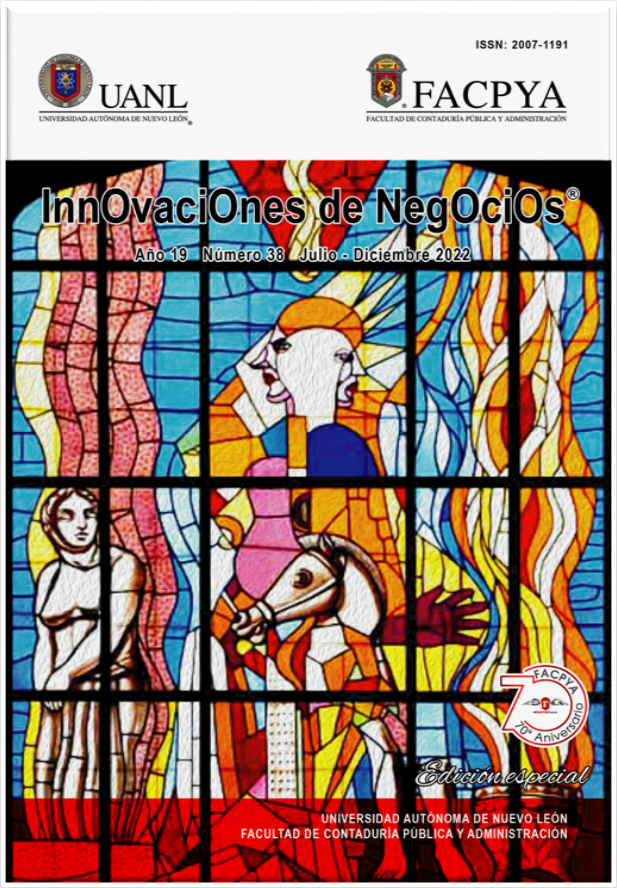Patent registration for the measurement of innovation in universities: bibliometric analysis
DOI:
https://doi.org/10.29105/revin19.38-397Keywords:
análisis bibliométrico, Educación Superior, Innovación, PatentesAbstract
The importance of patent registration constitutes the basis for the development of competitiveness and technological production indicators in educational organizations. There have been many changes in the way that universities respond to the needs of society, where scientific and technological activities are a main pillar in this context. Higher Education Institutions (HEI) develop new methods for technology transfer, which can be included and available in undergraduate, orientation, tutoring and postgraduate programs, as well as to be available to society in general. These have become generators of research in innovation processes that impact all sectors and one of their main indicators for measurement is the registration of patents. Based on the results, it is determined that the key elements for universities in innovation issues are publications and patent registration, since they generate applied knowledge. Therefore, the purpose of this work is to carry out an analysis from a bibliometric perspective, to find out the contents of the documents that help to determine the registration of patents as a measurement in innovation.
Downloads
References
Alcázar-Zamacona, J. &. -Z. (2016). Análisis Cuantitativo de Patentes en México. Global Conference on Business & Finance Proceedings, 830-837.
Archibugi, D., & Coco, A. (2004). A new indicator of technological capabilities for developed and developing countries (ArCo). World Development, 32(4), 629–654. http://doi.org/10.1016/j.worlddev.2003.10.008. DOI: https://doi.org/10.1016/j.worlddev.2003.10.008
Buesa, M. (1992). Patentes e innovación tecnológica en la industria española: 1967-1986, en J. L. García Delgado (coord.) y J. M. Serrano Sanz (col.), Economía española, cultura y sociedad: homenaje a Juan Velarde Fuertes. Eudema.
CEPAL. (2009). Innovar para Crecer: Desafíos y oportunidades para el desarrollo sostenible e inclusivo en Iberoamérica. CEPAL.
Conil, L. Y., de Velazco, J. H. (2010). Epistemología y praxis de la innovación como factor determinante en la durabilidad de la ventaja competitiva. Revista de Formación Gerencial, 9(1), 169-199.
Duque Oliva, E. J., Cervera Taulet, A., & Rodríguez Romero, C. (2006). A bibliometric analysis of models measuring the concept of perceived quality in providing internet service. Innovar, 16(28), 223–243.
Favila-Tello, A., & Armas-Arévalo, E. (2019). Determinantes de la capacidad de innovar en países de la OCDE. Investigación y Ciencia, (77), 63-72. DOI: https://doi.org/10.33064/iycuaa2019772123
Gutiérrez, H. A., Rebolledo, J. L. S., Ibarra, R. C., & Henneberry, D. (2008). Gestión de la innovación tecnológica en pymes agroindustriales chihuahuenses. Revista Mexicana de Agronegocios, 23, 681-694.
Jaramillo, H., & Albornoz, M. (1997). El universo de la medición: la perspectiva de la ciencia y la tecnología. Tercer Mundo.
Instituto Mexicano de la Propiedad Intelectual IMPI, G. D. (2019). Solicitud de registro de marca ante el IMPI.
Kan Yeung, A. W.; Goto, T. K. and Leung, W. K. 2017. The changing landscape of neuroscience research, 2006-2015: a bibliometric study. Frontiers in Neuroscience. 11, 120-127. DOI: https://doi.org/10.3389/fnins.2017.00120
Khan, M. y Dernis, H. (2006). Global Overview of Innovative Activities from the Patent Indicators Perspective". OECD Science, Technology and Industry Working Papers 2006/3.
Khayyat, N. T., & Lee, J.-D. (2015). A measure of technological capabilities for developing countries. Technological Forecasting and Social Change, 92, 210–223. http://doi.org/10.1016/j.techfore.2014.09.003 DOI: https://doi.org/10.1016/j.techfore.2014.09.003
Mahroum, S., Al-Saleh, Y. (2013). Towards a functional framework for measuring national innovation efficacy. Technovation, 33(10-11), 320–332. Recuperado el 16 de mayo de 2021: http://doi.org/10.1016/j.technovation.2013.03.013 DOI: https://doi.org/10.1016/j.technovation.2013.03.013
Manrique, J., Robledo, J., & Lema, Á. (2014). Índice de desempeño innovador en los subsectores industriales colombianos. Investigación y Reflexión, 22(2), 79–95. DOI: https://doi.org/10.18359/rfce.627
Manual de Oslo, 2005. http://portal.uned.es/portal/page?_pageid=93,23280929&_dad=portal&_schema=PORTAL
Narin, F., Hamilton, K. and Olivastro, D. (1997). The increasing linkage between US technology and public science. Research Policy, 317-330. DOI: https://doi.org/10.1016/S0048-7333(97)00013-9
Norris, M. & Oppenheim, C. (2007). Comparing alternatives to the Web of Science for coverage of the social sciences’ literature. Journal of Infometrics, 1(2), 161–169 DOI: https://doi.org/10.1016/j.joi.2006.12.001
OCDE (2005) Oslo Manual. Guidelines for collecting and interpreting innovation data, Paris, OECD.
Perkmann, M., Tartari, V., McKelvey, M., Autio, E., Broström, A., D’Este, P., ... & Krabel, S. (2016). Academic engagement and commercialization: A review of the literature on university–industry relations. Research policy, 42(2), 423-442. DOI: https://doi.org/10.1016/j.respol.2012.09.007
Pérez, C. D. (2014). Patentes académicas en México. Asociación Nacional de Universidades e Instituciones de Educación Superior.
Porter, M. E., Stern, S. (1999). The New Challenge to America’s Prosperity: Findings from the Innovation Index, Council on Competitiveness.
Rice, E. A. B. (2013). El papel de la Ventaja Competitiva en el desarrollo económico de los países. Análisis económico, 28(69), 55-78.
Quintas Corredoira, M. F. (2012). The protection of the inventions across patents in european, japanese and american universities. Cuadernos de Gestión, 15-38. DOI: https://doi.org/10.5295/cdg.100205mq
Senel, E., Demir, E. (2015). A global productivity and bibliometric analysis of telemedicine and teledermatology publication trends during 1980 e 2013. Dermatología Sinica, 33, 16–20. DOI: https://doi.org/10.1016/j.dsi.2014.10.003
Secretaría de Economía. (2019, 13 febrero). Universidades y centros de investigación nacionales que registran https://www.gob.mx/se/articulos/universidades-y-centros-de-investigacion-nacionales-que-registran-mas-patentes-en-mexico?idiom=es
Scherer, F. M., & Size, F. (1965). Market Structure, Opportunity and the Output of Patented Innovation'. American Economic Review.
Spitzer, D. (2007). Rethinking innovation measurement. IBM Corporation.
Downloads
Published
How to Cite
Issue
Section
License
Copyright (c) 2022 Omar Guillermo Arriaga Cárdenas, Paola del Carmen Lara Magaña, José Sánchez Gutiérrez

This work is licensed under a Creative Commons Attribution-NonCommercial-ShareAlike 4.0 International License.
The InnOvaciOnes de NegOciOs magazine is a free and open access electronic magazine of a scientific-academic nature and is a publication of the Autonomous University of Nuevo León, in which the authors retain their copyright and grant the magazine the exclusive right to first publication of the work. Third parties are allowed to use the published content, as long as the authorship of the work is acknowledged and the first publication in this journal is cited.
For more information, please contact the Research Secretary (FACPyA) of the Autonomous University of Nuevo León. Telephone: (81) 1340-4430. Email: revinnova@uanl.mx










